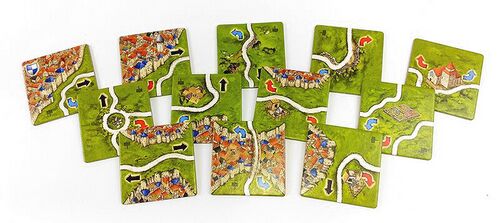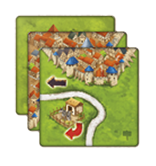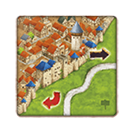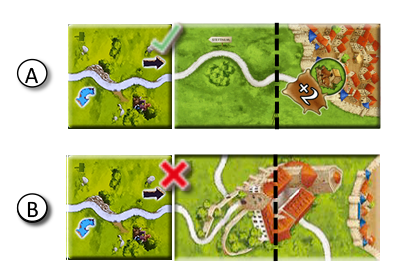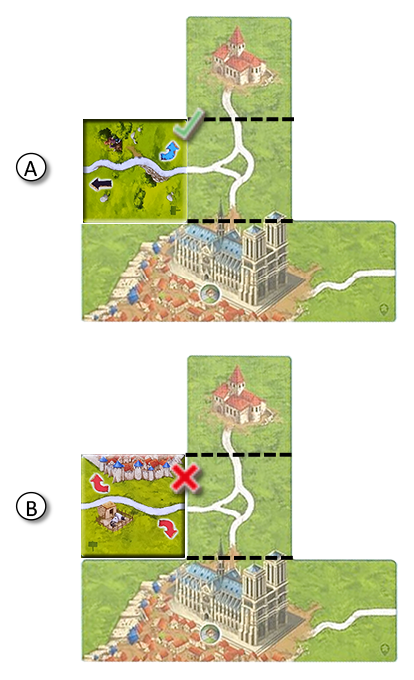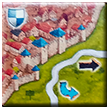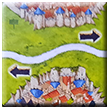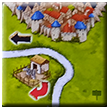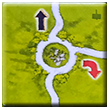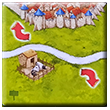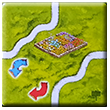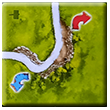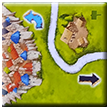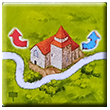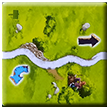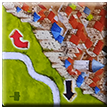Les Panneaux d’Indication
General info and comments
Les Panneaux d’Indication a été publié par Hans im Glück en 2021.
Cette extension comporte des villes avec des bâtiments coupés.
Cette mini extension a été conçue pour le jeu de base de Carcassonne et suit donc, en plus des règles ci-dessous, les règles normales du jeu. Vous pouvez l’utiliser avec toutes les autres extensions du jeu, mais il n’existe aucune règle officielle pour expliquer les différentes interactions possibles.
Matériel
- 12 nouvelles tuiles Terrain comportant chacune 2 des 3 différents types de panneaux d’indication :
Règles
Mise en place
Mélangez les 12 tuiles de cette mini extension avec les autres tuiles Terrain.
Déroulement du jeu
1. Placement d’une tuile
Vous piochez une tuile Terrain et la placez en respectant les règles habituelles.
2. Pose d’un meeple
Vous pouvez poser un meeple sur la tuile qui vient d’être placée [1].
3. Évaluation des zones
Lorsque vous complétez une route, vérifiez s'il y a des panneaux d’indication à côté. Si c'est le cas, en plus des points de la route, vous marquez également des points pour chaque panneau d’indication indiquant la bonne direction [2].
Pour qu’un panneau d’indication pointe dans la bonne direction, les conditions suivantes doivent être remplies :
- La direction de la route sur la tuile suivante doit correspondre à la direction indiquée par le panneau d’indication (tourner à gauche, tourner à droite ou aller tout droit).
- La route ne doit pas se terminer sur la première tuile après le panneau d’indication.
Comment compter les panneaux d’indication :
- Comptez les panneaux indiquant la bonne direction sur la route que vous voulez évaluer.
- À partir de là, comptez le nombre de types différents de panneaux d’indication.
Vous pouvez évaluer :
- 1 seul type de panneau d’indication : 1 point pour chaque panneau correct.
- 2 types différents de panneaux d’indication : 2 points pour chaque panneau correct.
- Les 3 différents types de panneaux d’indication : 3 points pour chaque panneau correct.
Vous ne recevez pas de points pour les panneaux qui n’indiquent pas la direction correcte de la route.
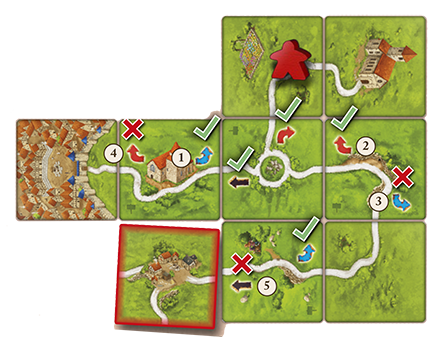
Trois flèches sont incorrectes
Vous completez votre route en plaçant la tuile et marquez 9 points.
Pour les 5 panneaux corrects
Évaluation finale
À la fin du jeu, vous recevez 1 point pour chaque panneau d’indication sur vos routes indiquant la bonne direction. Les différents types de panneaux n’ont pas d’importance à ce stade.
Autres extensions
This section contains additional information about the interactions with other Carcassonne expansions.
- Observations générales
 Les règles supposent que la condition du panneau d’indication est remplie si une section de route relie le côté du panneau d’indication au côté requis sur la tuile adjacente. Si la section de route se termine sur la tuile avant de toucher le côté requis ou ne le touche pas du tout, la condition du panneau d’indication n’est pas remplie.
Les règles supposent que la condition du panneau d’indication est remplie si une section de route relie le côté du panneau d’indication au côté requis sur la tuile adjacente. Si la section de route se termine sur la tuile avant de toucher le côté requis ou ne le touche pas du tout, la condition du panneau d’indication n’est pas remplie.
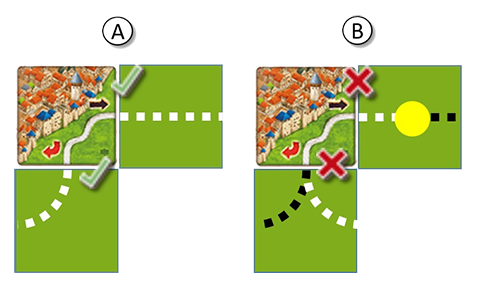 Exemple 3 : Cette image montre des exemples répondant à la condition du panneau d’indication (cas A) et ne la respectant pas (cas B). Le cas B indique une route droite (pointillée en blanc) qui se termine par un élément de la tuile (cercle jaune) et ne se poursuit donc pas jusqu’au côté opposé (section pointillée en noir), et une route courbe (pointillée en blanc) qui ne répond pas à l’exigence du panneau d’indication (pointillée en noir).
Exemple 3 : Cette image montre des exemples répondant à la condition du panneau d’indication (cas A) et ne la respectant pas (cas B). Le cas B indique une route droite (pointillée en blanc) qui se termine par un élément de la tuile (cercle jaune) et ne se poursuit donc pas jusqu’au côté opposé (section pointillée en noir), et une route courbe (pointillée en blanc) qui ne répond pas à l’exigence du panneau d’indication (pointillée en noir).
- D’une manière générale, la section de route doit relier les côtés requis pour remplir les conditions, mais cette connexion peut inclure d’autres zones qui assurent cette connexion sur la tuile au-delà d’une simple route imprimée sur la tuile.
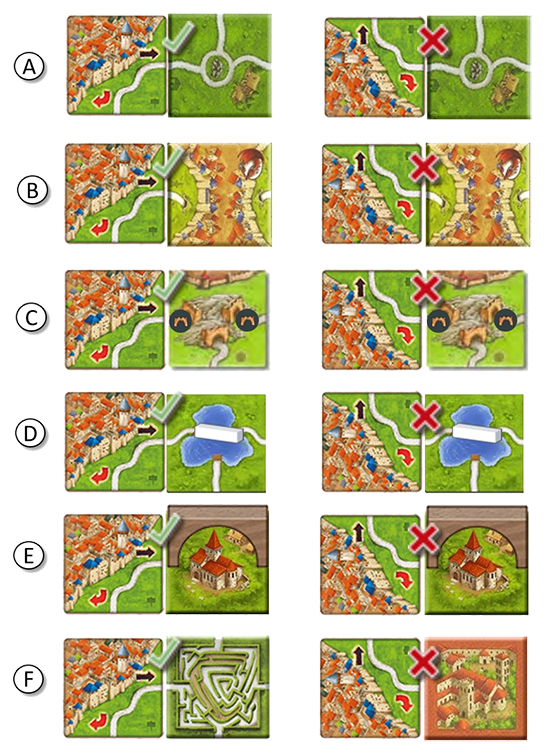 Example 4: Roads may include a number of features affecting them and even modify their layout at times. The rules cover roundabouts (case A). For other features, the same logic should apply also covered in the image:
Example 4: Roads may include a number of features affecting them and even modify their layout at times. The rules cover roundabouts (case A). For other features, the same logic should apply also covered in the image:- Tunnels without tunnel tokens (case B) and with them (case C)
- Ferries (case D)
- Bridges (case E)
Case C-right may present many variations when not meeting the signpost condition:- The signpost road enters a tunnel and exits on the same tile but not reaching the required edge (the case presented in the example)
- The signpost road enters a tunnel and exits on another tile (the second tunnel token is placed on another tile) including those where the tunnel entrance connected to the signpost has no tunnel token or the exit tunnel token may be placed on another tile, if any
- The signpost road enters the tunnel but it may not exit (no tunnel token on the entrance or no second tunnel token to match it)
The labyrinth (case F-left) would always meet the signpost condition, the same as the 4-legged roundabouts featured on the Spiel '18 tile (Spiel Promos) or in Exp. 7 - The Catapult. The abbey tile (Exp. 5 - Abbey & Mayor) would never meet the condition (case F-right), the same as any edge with a city gate.
The signpost requirements will apply to roads on Halfling tiles (Halflings), double-sized tiles (the river source in the 20th Anniversary River, the German castles in Castles in Germany or the tiles in The Markets of Leipzig) and tiles in other shapes (the 2x2 starting tile in Exp. 11 - Ghosts, Castles & Cemeteries and the wonder tiles in The Wonders of Humanity).
![]() The signposts requirements applied to a road segment on square tiles should also apply to a road on Halflings, following a few considerations:
The signposts requirements applied to a road segment on square tiles should also apply to a road on Halflings, following a few considerations:
- A road connecting two edges on one Hafling tile should meet the same conditions as if it was a square tile.
- A road spanning across two triangular tiles should be considered as a road segment on a square tile to meet the signpost condition.
- A road ending at a feature or at a triangular gap will not meet the conditions for any signpost.
 Example 5: Roads spanning across two Halfling tiles should be considered as one square tile to decide if they meet the signpost requirement. Case A-left, case A-right and case B-left show examples where the road spans across two Halfling tiles.
Example 5: Roads spanning across two Halfling tiles should be considered as one square tile to decide if they meet the signpost requirement. Case A-left, case A-right and case B-left show examples where the road spans across two Halfling tiles.
Case B-right shows a road on a triangular tile that will not meet the signpost requirement.
Case C-left shows a road on just one triangular tile that meets the condition of the signpost. However, case C-right shows a road not meeting the signpost condition, since it is interrupted at the long edge of the tile, that is, it meets a triangular gap.
![]() The signposts requirements applied to a road segment on a square tile should also apply to a road on a double-sized tile, with the following considerations:
The signposts requirements applied to a road segment on a square tile should also apply to a road on a double-sized tile, with the following considerations:
- A road ending on one half of a double-sized tile will not meet the conditions for any signpost.
- A long road on a Leipzig tile ends on the tile, but each half of the double-sized tile is considered as a separate square tile when evaluating signposts. The road segment will then meet the condition for a straight signpost.
![]() The signposts requirements applied to a road segment on a square tile should also apply to a road on a wonder tile or on a 2x2 tile, with the following considerations:
The signposts requirements applied to a road segment on a square tile should also apply to a road on a wonder tile or on a 2x2 tile, with the following considerations:
- A long road on a wonder tile may end or not on the tile. It may even fork on the tile. Each square space in a wonder tile should be considered as a separate tile when evaluating signposts involving them.
- A road segment ending at a dirt patch before reaching the edge of its square space will not meet the requirement for any signpost type.
- A road segment reaching the opposite or adjacent edge of its square space will meet the requirement for the corresponding signpost type.
- A road segment on a 2x2 tile ends at a feature on the tile, so it will not meet the condition for any signpost.
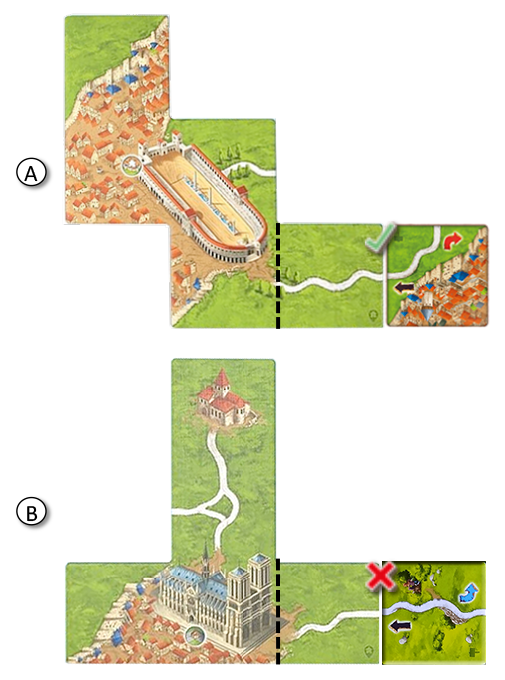 Example 8: Roads on wonder tiles are evaluated by considering each square space as a separate tile. Case A shows a correct signpost for a straight road segment reaching the opposite edge of the square space. Case B shows an incorrect signpost for a straight road segment ending at a dirt patch before reaching the opposite edge of the square space.
Example 8: Roads on wonder tiles are evaluated by considering each square space as a separate tile. Case A shows a correct signpost for a straight road segment reaching the opposite edge of the square space. Case B shows an incorrect signpost for a straight road segment ending at a dirt patch before reaching the opposite edge of the square space.
![]() The extra points scored for the correct signposts is a feature-level scoring modifier the same as the points scored for:
The extra points scored for the correct signposts is a feature-level scoring modifier the same as the points scored for:
- Bathhouses (The Barber-Surgeons)
- German castles (Castles in Germany)
- Labyrinth with advanced rules (The Labyrinth)
- Little Buildings (Little Buildings)
These points will be added to the feature after applying other scoring modifiers such as:
- Inns (Exp. 1 - Inns & Cathedrals)
- German cathedrals (Cathedrals in Germany)
- Mage and Witch (Mini #5 - Mage & Witch).
![]() The points for the correct signposts are part of the total scoring for the feature, the same as the other feature-level scoring modifiers. These points are not a separate scoring event when considering the following cases:
The points for the correct signposts are part of the total scoring for the feature, the same as the other feature-level scoring modifiers. These points are not a separate scoring event when considering the following cases:
- A castle scoring (Exp. 8 - Bridges, Castles & Bazaars)
- Messages #1 and #8 scoring points for a road (Mini #2 - The Messengers)
- A Robber stealing points from a road scoring (Mini #6 - The Robbers)
}}
{{OtherExpansionRule|expansionlink=![]() Ext. 5 – Maires et Monastères|rules=
Ext. 5 – Maires et Monastères|rules=
- Ext. 5 – Maires et Monastères :
 Tout panneau sur un bord de route relié à une tuile Monastère sera considéré comme étant dans une position incorrecte.
Tout panneau sur un bord de route relié à une tuile Monastère sera considéré comme étant dans une position incorrecte.
{{OtherExpansionRule|expansionlink=![]() Ext. 8 – Ponts, Forteresses et Bazars|rules=
Ext. 8 – Ponts, Forteresses et Bazars|rules=
- Ext. 8 – Ponts, Forteresses et Bazars :
 Un pont doit être considéré comme une section de route droite.
Un pont doit être considéré comme une section de route droite.
![]() Messages #1 and #8 will take the signposts into consideration when scoring a road (1 point per correct signpost, as if scoring after the game).
Messages #1 and #8 will take the signposts into consideration when scoring a road (1 point per correct signpost, as if scoring after the game).
![]() The Wainwrights quarter bonus is not affected by signposts.
The Wainwrights quarter bonus is not affected by signposts.
![]() The long road on a Leipzig tile ends on the tile, but each half of the double-sized tile is considered as a separate square tile when evaluating signposts. The road segment will then meet the condition for a straight signpost.
The long road on a Leipzig tile ends on the tile, but each half of the double-sized tile is considered as a separate square tile when evaluating signposts. The road segment will then meet the condition for a straight signpost.
![]() The road segments on the German castle tiles end on the double-sized tile, so they will not meet the requirements for any signpost.
The road segments on the German castle tiles end on the double-sized tile, so they will not meet the requirements for any signpost.
![]() Roads ending at a German cathedral will receive extra points for the correct signpost on the road.
Roads ending at a German cathedral will receive extra points for the correct signpost on the road.
![]() An archbishop will not score extra points for the correct signpost on the road ending at the German cathedral.
An archbishop will not score extra points for the correct signpost on the road ending at the German cathedral.
![]() Two triangular tiles sharing the same square space will be considered as one regular tile regarding signposts, so those roads running across both tiles will be considered as a road on a square tile.
Two triangular tiles sharing the same square space will be considered as one regular tile regarding signposts, so those roads running across both tiles will be considered as a road on a square tile.
![]() A road interrupted at a triangular gap or ending at a triangular tile will not meet the requirements for a correct signpost.
A road interrupted at a triangular gap or ending at a triangular tile will not meet the requirements for a correct signpost.
![]() La Rivière du 20ᵉ Anniversaire
La Rivière du 20ᵉ Anniversaire
![]() The road segment on the double-sized river source tile ends on tile, so it will not meet the requirements for any signpost.
The road segment on the double-sized river source tile ends on tile, so it will not meet the requirements for any signpost.
![]() The Road Sweeper gift card will take the signposts into consideration when scoring a road (1 point per correct signpost, as if scoring after the game).
The Road Sweeper gift card will take the signposts into consideration when scoring a road (1 point per correct signpost, as if scoring after the game).
Ensemble des tuiles
Notes
Pour les licences et les explications des icônes, veuillez visiter la page des icônes.
- ↑
 Vous ne pouvez pas poser un meeple sur une flèche. Elles ne peuvent pas être revendiqués ou évalués séparément des routes sur la tuile.
Vous ne pouvez pas poser un meeple sur une flèche. Elles ne peuvent pas être revendiqués ou évalués séparément des routes sur la tuile.
- ↑
 Les points supplémentaires marqués pour le bon panneau d’indication font partie de l’évaluation des zones et ils ne sont reçus que par le ou les joueurs ayant la majorité.
Les points supplémentaires marqués pour le bon panneau d’indication font partie de l’évaluation des zones et ils ne sont reçus que par le ou les joueurs ayant la majorité.
